Other common names:
Curlytop gumweed, gumweed, resin weed, rosinweed, tarweed
Scientific name:
Grindelia squarrosa
Family:
Asteraceae
Description:
Curlycup gumweed grows as a ground-hugging rosette form in the first year, and then sends up branched, semi-woody stems and flowers in the second year, growing 1 to 3 feet tall. It blooms during the summer. The entire plant is aromatic.
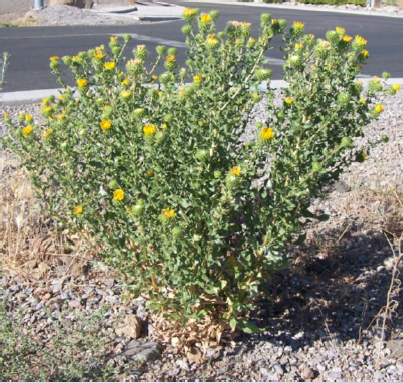
Typical plant growing in a disturbed site.
Leaves:
Alternately attached leaves are 1 to 3 inches long, thick and have toothed edges. They attach directly to the stems and ooze a sticky material.
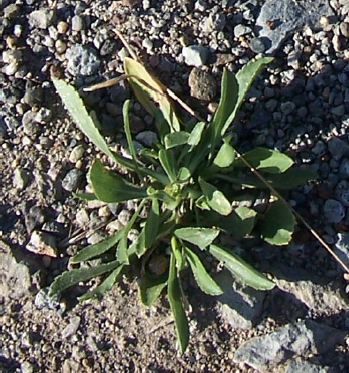
Young plants grow in a low rosette form.
Stems:
Stiff and branched.
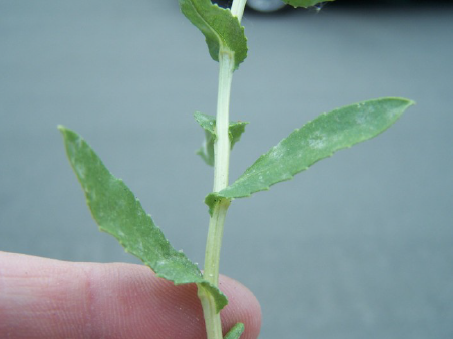
The leaves have toothed edges and clasp the stem.
Flowers:
Yellow; borne on heads about 1/2 to 1 inch in diameter. Structures below the petals curve downward and are covered with a sticky resin.
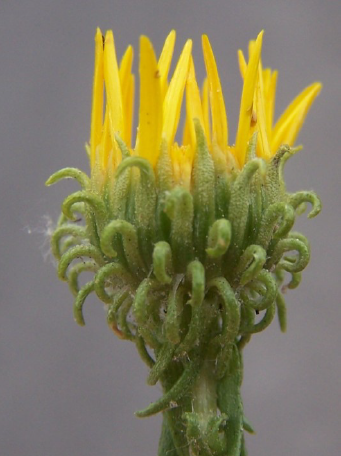
The yellow flower is covered with a sticky resin.
Roots:
Grows a large, tough taproot.
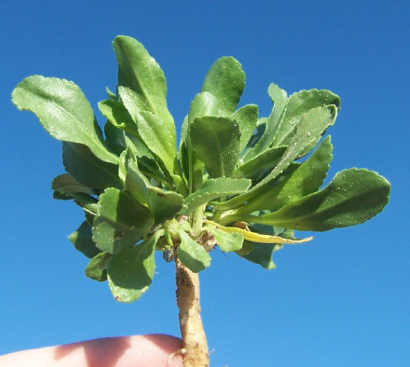
The young plant has a well-developed taproot.
Native to:
North America
Where it grows:
Roadsides, pastures, rangelands, vacant lots and other disturbed or unmanaged sites
Life cycle:
Biennial (lives two years) to short-lived perennial (grows back each year from the roots)
Reproduction:
Reproduces by seed
Control methods:
Curlycup gumweed is best controlled when young. Mature plants are difficult to remove mechanically due to the large taproot and semi-woody stems.
Mechanical:
Dig, hoe or pull young plants. Plants that are mowed or break off at the crown will regrow. The tough taproot makes pulling mature plants difficult, if not impossible. Woody stems make it difficult to remove by weed-whacking.
Cultural:
Does not tolerate regular disturbance or competition. Plant desirable vegetation to help suppress the gumweed.
Biological:
None commercially available. Curlycup gumweed may concentrate the mineral selenium to levels that can be toxic to cattle, although they generally avoid eating the plant. Poorly managed grazing favors gumweed.
Chemical:
Try broadleaf-selective herbicides such as 2,4-D and dicamba on young plants. Dicamba can persist for several months and may damage desirable plants in the area treated. Pre-emergence herbicides can be used to manage existing seed banks. Glyphosate is generally not effective on this plant.
References:
All the photos above are by S. Donaldson.
DiTomaso, J.M. and E.A. Healy. 2007. Weeds of California and Other Western States. University of California Publication 3488.
Peachy, E. (editor). 2011. Pacific Northwest Weed Management Handbook. Oregon State University, PNW.
Whitson, Tom D. (editor). 2002. Weeds of the West. University of Wyoming, Jackson, Wyoming.
USDA-NRCS Plants Database. 2011. PLANTS profile for Grindelia squarrosa, USDA.
Donaldson, S. and Hanson Mazet, W.
2011,
A Northern Nevada Homeowner’s Guide to Identifying and Managing Curlycup Gumweed,
Extension | University of Nevada, Reno, FS-11-60


